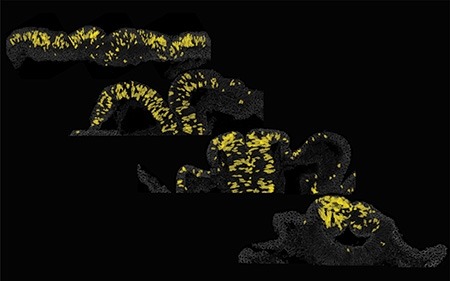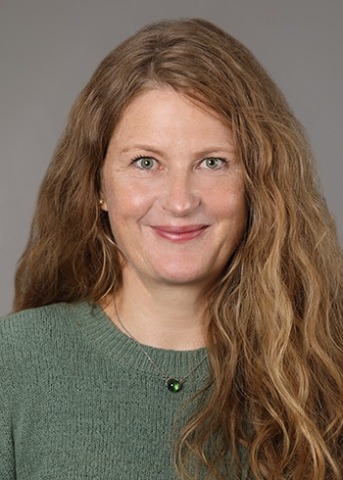Three Germ Layers and a Paradigm Shift
New insights into neural crest stem cells
In Brief:
- NIDCR researchers made an unexpected discovery that helps to answer a long-standing mystery tied to a group of stem cells that are key to vertebrate development.
- The finding could help scientists better grasp how neural crest development goes awry to cause birth defects.
Just as records are meant to be broken in sports and at the box office, paradigms are meant to be shifted in biology as new data emerge that advance our basic understanding of life. As published in the journal Nature Communications, a team of NIDCR researchers has made an unexpected discovery that helps answer a long-standing mystery tied to a group of stem cells that are key to the development of vertebrates, from reptiles to birds to mammals, including humans.
These stem cells, called neural crest cells, appear early in the embryo and eventually give rise to the facial skeleton, parts of the teeth and salivary glands, as well as to portions of the heart, nerves, and skin. The NIDCR scientists, led by Stadtman Tenure Track Investigator Laura Kerosuo, Ph.D., had been trying to understand how neural crest cells hold on to their ability to turn into all these different cell types longer than any other stem cells in the embryo. The answer they found challenges a fundamental paradigm within the developmental biology of vertebrates. It also adds to basic knowledge that will help scientists better grasp how neural crest development goes awry to cause birth defects such as cleft lip with or without cleft palate, Treacher-Collins syndrome, CHARGE syndrome, and DiGeorge syndrome.
The paradigm involves what developmental biologists call gastrulation. It’s a crucial phase of early fetal development when dividing cells form into three distinct germ layers of tissue. Each layer of this fetal structure, called a gastrula, forms from dividing stem cells with the potential to spawn virtually any cell lineage needed to give rise to, in our case, the roughly 200 cell types that comprise the human body. This stem cell superpower is called pluripotency.
By the end of gastrulation, according to the paradigm, stem cells lose their pluripotency. In each layer, stem cells commit to specific developmental paths that are needed to assemble distinct body systems. For example, stem cells in the ectoderm, the outermost of the layers, restrict their potential to forming tissues of the skin, sweat glands, hair, and tooth enamel, as well as the spinal cord, peripheral nerves, and brain.
But Kerosuo’s team, including graduate student and study first author Ceren Pajanoja, MSci, discovered in animal studies that stem cells throughout the ectoderm keep their stemness longer than previously thought. Unlike their counterparts in the other two layers, ectoderm stem cells continue to maintain a genetic signature that is a hallmark of continued pluripotency beyond gastrulation.
This surprising finding helps shed light on a feature of neural crest cells that has long puzzled scientists. These ectoderm-derived stem cells, which are unique to vertebrates, have stood out for years as the exception to the rule about lost pluripotency during gastrulation. In fact, neural crest cells emerge nearly fully pluripotent after gastrulation and capable of spawning the development of a wide array of tissues, such as the facial bone and cartilage and endocrine cells, not just those of typical ectodermal origin.
“Some in the field had proposed that pluripotency is innate to neural crest cells, and this superpower is somehow protected in them through gastrulation,” said Kerosuo. “Others had suggested that neural crest cells have the unique ability to reactivate their pluripotency after gastrulation.”
The latest data, based on the first comprehensive genomic analyses of individual cells during early development, support a third answer: the entire ectoderm itself maintains the cellular conditions for pluripotency during gastrulation. Neural crest cells are the products of their ectodermal environment.
The neural crest cells then take their place for the next stage of embryo development, called neurulation, in which a neural tube forms to prompt the development of the brain and spinal cord. That’s where the NIDCR team made another key discovery. By the end of neurulation, cells in other parts of the ectoderm have gradually reduced their gene signatures for pluripotency — except the neural crest cells.
As the late developmental biologist Lewis Wolpert once stated, "It is not birth, marriage, or death, but gastrulation which is truly the most important time in your life." Following Wolpert’s dictum, these new data will help to better frame scientists’ thinking about early development and what can go wrong to cause birth defects.
The data also will inform future strategies to repair damaged human tissues or recreate new ones. Indeed, this work puts researchers in a better position to learn precisely when and how to tap into the regenerative capacity of ectodermal cells, including neural crest cells. That knowledge could enable scientists to reprogram cells on demand to reconstruct tissues of the head, face, and mouth. It could also shed light on the causes of neural crest-derived cancers such as melanoma and neuroblastoma.
Related Links
Reference
Pajanoja C, Hsin J, Olinger B, Schiffmacher A, Yazejian R, Abrams S, et al. Maintenance of pluripotency-like signature in the entire ectoderm leads to neural crest stem cell potential. Nat Commun. 2023 Sep 23;14(1):5941. doi: 10.1038/s41467-023-41384-6.
Attention Editors
Reprint this article in your own publication or post to your website. NIDCR News articles are not copyrighted. Please acknowledge NIH's National Institute of Dental and Craniofacial Research as the source.
Subscribe for NIDCR Updates
Receive email updates about the latest advances in dental, oral, and craniofacial research.
November 2024


